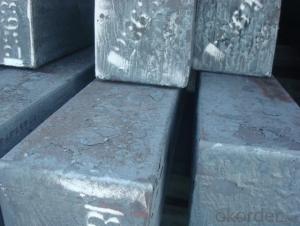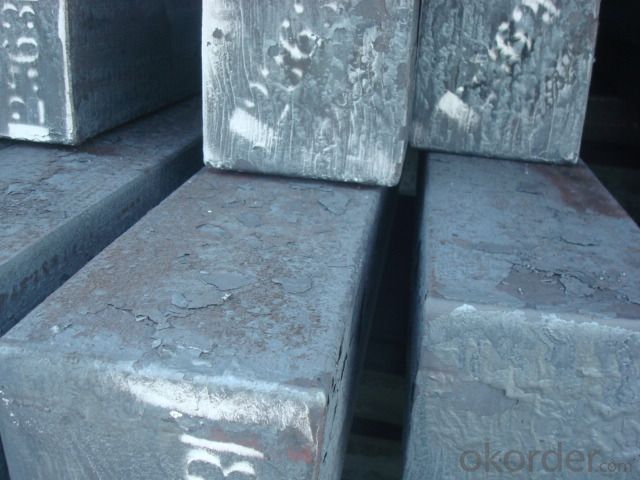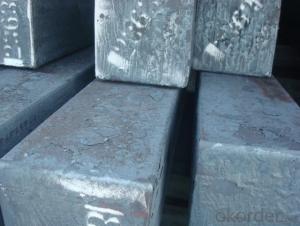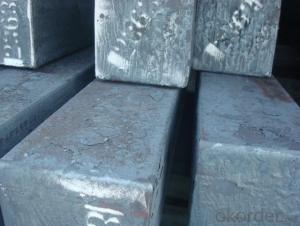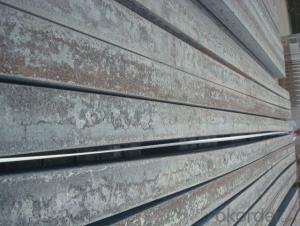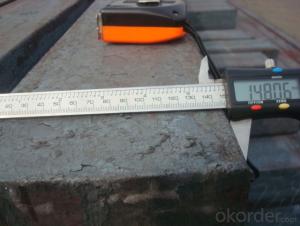Continue Casting Steel Billet Made by Blast Furnace
- Loading Port:
- Tianjin
- Payment Terms:
- TT OR LC
- Min Order Qty:
- 1000 m.t.
- Supply Capability:
- 100000 m.t./month
OKorder Service Pledge
OKorder Financial Service
You Might Also Like
Continue Casting Steel Billet Made by Blast Furnace
1.Structure of Continue Casting Steel Billet Made by Blast Furnace
Continue Casting Steel Bloom by Blast Furnace is the raw material of all kinds of steel mill. Billet section of square, round, flat, rectangular and abnormity, etc Several, mainly related to shape of rolled products. Simple rolled section steel, choose cross section of square billet or rectangular billet. rolling The sector products such as flat steel, Angle steel, select the rectangular billet or slab. Had better profiled billet when production beams, channels, and in rolling process Lines and improve the yield. The raw material of round billet is the production of seamless tube.
2.Main Features of Continue Casting Steel Billet Made by Blast Furnace
Continue Casting Steel Bloom by Blast Furnace section size should meet the requirements of rolling deformation and finished product quality, but also roll strength and biting condition of restrictions. General steel Billet section height H. And the roll diameter D The ratio of the ( namely H/D) Should be less than or equal to zero 0.5 . Length of steel billet by finishing temperature, Rolling time and the length of the product Or times ruler. When heated too long accident prone to bump the furnace wall of steel, too short, furnace bottom utilization rate is not high, influence the heating furnace production. For the production Choose a variety of steel and steel billet, should consider the affinities of billet, as far as possible in order to improve the productivity of the roughing mill, simplify the stock management of workshop.
3. Continue Casting Steel Billet Made by Blast Furnace Images
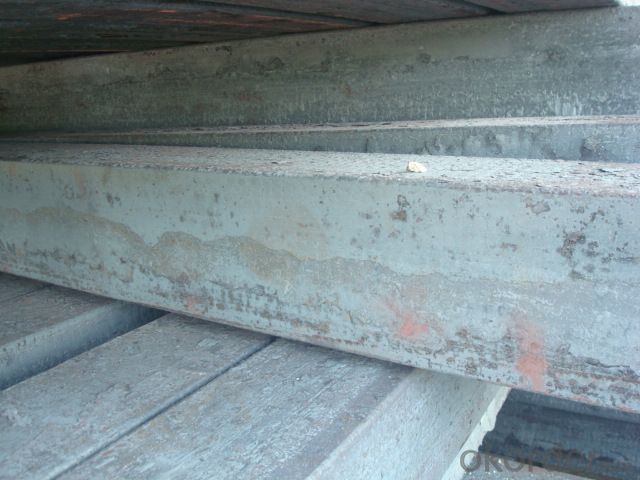
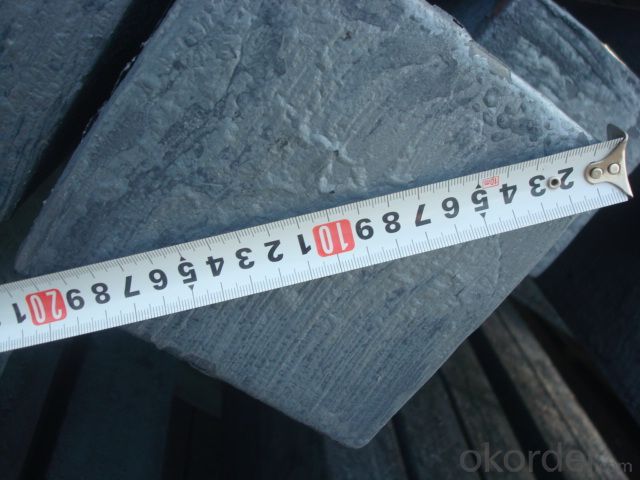
4. Continue Casting Steel Billet Made by Blast Furnace Specification
Continue Casting Steel Bloom by Blast Furnace rolled steel, after processing can be used for mechanical parts, forging parts, processing all kinds of steel, steel Q345B channel steel, wire rod is the role of the billet. Steel billet is used in the production of semi-finished products, generally cannot be used directly for the society. Steel billets and steel are strictly divided into standard, cannot decide to whether the business enterprise of the final product, and according to unified standards to perform the whole society. Typically, billet and the steel is relatively easy to distinguish, but for some steel billet, and have the same specification and same steel purposes (such as rolling tube billet), whether can be used for other industries, whether through steel processing process, whether through a finished product rolling mill processing to distinguish
Mainly from the shape is divided into two kinds:Slab: cross section width and height of the ratio of the larger, mainly used for rolling plate.Billet: equal cross section width and height, or a huge difference, mainly used for rolling steel, wire rod.Material part of the standard:Range of thickness: 150-240 - mm + / - 5 mmThe width of the range: 880-1530 - mm + / - 20 mmLength: 3700-10000 - mm + / - 500 - mmCross-sectional size: 64 * 64;82 * 82;98 * 98;124 * 124;120 * 150;152 * 164;152 * 170 mm
5.FAQ of Continue Casting Steel Billet Made by Blast Furnace
We have organized several common questions for our clients,may help you sincerely:
①How we can recoginize the blast furnace and the efa quality?
If you see the surface only, not very easy to recognize, it is better you buy from CNBM and we have to keep the contract as we sign, it is more relieable.
②Could we get the original MTC from the steel mill?
Yes, you can.
③If we found any quality problem, how long you can settel that for us?
about 7-30days with SGS report.
- Q: How are steel billets used in the manufacturing of pipeline fittings?
- Steel billets are used in the manufacturing of pipeline fittings by being heated and shaped into the desired form. They serve as the raw material that is then further processed and machined to create various types of fittings such as elbows, tees, reducers, and flanges. The steel billets undergo a series of forging, cutting, and welding processes to achieve the required dimensions and specifications for the pipeline fittings.
- Q: How are steel billets marked for identification and traceability?
- Steel billets are marked for identification and traceability using various methods. One common method is through the use of unique identification numbers or codes. These numbers or codes can be engraved or stamped onto the surface of the billet, making it easily identifiable. This marking can be done using specialized equipment such as laser engraving machines or steel stamping tools. In addition to identification numbers, other important information such as the grade, heat number, and production date can also be marked on the billet. This information is crucial for traceability purposes and helps in tracking the origin and quality of the steel. Furthermore, some manufacturers may opt to use additional marking techniques such as paint or ink marking. This can involve using specific colors or symbols to represent different characteristics or attributes of the billet. For instance, a specific color may indicate the steel's intended use or a symbol may represent the manufacturer's logo or quality certification. Overall, marking steel billets for identification and traceability is essential in ensuring quality control, verifying compliance with industry standards, and facilitating efficient inventory management throughout the supply chain.
- Q: How do steel billets compare to other types of metal billets?
- Steel billets possess several advantages over other types of metal billets. Firstly, the outstanding strength and durability of steel make it highly resistant to wear and tear, rendering steel billets suitable for a wide range of applications in the construction, automotive, and manufacturing industries. Furthermore, steel billets exhibit excellent heat resistance, enabling them to endure high temperatures without distorting or compromising their structural integrity. This quality makes steel billets perfect for the production of components that are subjected to extreme heat, such as engine parts or industrial machinery. Moreover, steel billets provide versatility in terms of shape and size. They can be effortlessly molded and formed into various configurations, empowering manufacturers to create intricate and complex designs. This adaptability makes steel billets the preferred choice in industries that necessitate customized or intricate parts. Additionally, steel billets boast high recyclability, making them an environmentally sustainable choice. The recycling process of steel requires significantly less energy compared to other metals, resulting in reduced carbon emissions and environmental impact. This aspect has led to an increased preference for steel billets in industries that prioritize sustainability and environmental responsibility. In conclusion, steel billets surpass other metal billets due to their exceptional strength, heat resistance, versatility, and recyclability. These qualities make steel billets the preferred choice for numerous industries, offering a combination of durability, functionality, and environmental sustainability.
- Q: How do steel billets contribute to the overall strength of a finished product?
- Steel billets contribute to the overall strength of a finished product by providing a solid and dense starting material. Due to their high carbon content and precise manufacturing process, steel billets offer superior mechanical properties, such as hardness and tensile strength. These attributes enable the billets to withstand heavy loads and resist deformation, ensuring that the final product possesses the necessary strength and durability.
- Q: Are steel billets subject to any heat treatment processes?
- Yes, steel billets are subject to heat treatment processes. Heat treatment processes such as annealing, normalizing, quenching, and tempering can be applied to steel billets to enhance their mechanical properties and improve their overall performance.
- Q: How is the quality of steel billets determined?
- The quality of steel billets is determined through various factors including chemical composition, physical properties, and visual inspection. Chemical composition analysis involves measuring the levels of different elements present in the billets such as carbon, manganese, and sulfur, as well as checking for any impurities. Physical properties such as tensile strength, hardness, and toughness are tested to ensure the billets meet the required specifications. Visual inspection is also performed to identify any defects like cracks, surface abnormalities, or unevenness. Combining these assessments helps determine the overall quality of steel billets.
- Q: Who knows the diamond is?Who knows the diamond is carbon? Is it C60?
- It is also called the diamond diamond, crystal, it is not the molecules themselves, so the formula does not apply to.C said it is only by this kind of carbon elements. While C60 is footballene is another matter, the 60 is because it is a molecular crystal, each molecule consists of 60 carbon.
- Q: What are the international standards or certifications for steel billets?
- Steel billets are subject to various international standards and certifications, which guarantee their quality, safety, and compliance with industry regulations. One widely recognized standard is the ISO 9001 certification, which establishes criteria for a quality management system. This certification ensures that steel billet production adheres to international quality standards and consistently meets customer requirements. In addition to ISO 9001, the steel industry has other specific certifications. The ISO 14001 certification focuses on environmental management systems, ensuring that steel billet production follows sustainable practices. This certification demonstrates a commitment to minimizing environmental impact and promoting sustainable development. Another crucial certification is the ISO 45001, which emphasizes occupational health and safety management. This certification verifies that steel billet manufacturers have implemented effective safety protocols and procedures to protect employees and prevent workplace accidents. Moreover, the American Society for Testing and Materials (ASTM) establishes standards for steel billets, such as ASTM A615/A615M for deformed and plain carbon-steel bars used in concrete reinforcement. These standards outline mechanical properties, chemical composition, and testing methods for steel billets used in construction applications. Similarly, the European Committee for Standardization (CEN) sets standards for steel billets through the European Norm (EN) system. For example, EN 10025 specifies technical delivery conditions for structural steel products, including steel billets, used in various European industries. Adhering to these international standards and certifications is crucial for steel billet manufacturers. It ensures the quality, safety, and compliance of their products. Conforming to these standards not only enhances the manufacturer's credibility and reputation but also provides customers with confidence that the steel billets they purchase meet the highest industry standards.
- Q: What are the potential applications of steel billets in the aerospace aftermarket?
- The aerospace aftermarket offers a wide range of potential applications for steel billets. These applications encompass the production of various aerospace components, including engine parts, airframe structures, landing gear components, and fasteners. One possible use of steel billets in the aerospace aftermarket is for manufacturing engine parts. Critical components like turbine blades, compressor discs, and shafts can be produced using steel billets. These parts require high strength, durability, and resistance to extreme temperatures, all of which can be achieved through the utilization of steel billets. Additionally, steel billets can be employed to manufacture exhaust system components like manifolds and flanges, which also require high temperature resistance. Another significant application of steel billets in the aerospace aftermarket is in the production of airframe structures. Steel billets can be utilized to manufacture various structural components, including beams, frames, and brackets. These components are essential for providing strength and stability to the aircraft's fuselage, wings, and other structural elements. Steel billets offer the necessary strength-to-weight ratio, corrosion resistance, and fatigue resistance required for these demanding applications. Furthermore, steel billets have the potential to be used in the production of landing gear components in the aerospace aftermarket. Landing gear plays a critical role in the safe operation of an aircraft, and it must withstand significant loads and stresses during takeoff, landing, and taxiing. Steel billets can be machined into landing gear parts such as axles, struts, and wheels, which require high strength, toughness, and fatigue resistance. Lastly, steel billets find applications in the production of fasteners used in the aerospace aftermarket. Essential for joining various components together in an aircraft, fasteners such as bolts, screws, and nuts are vital for secure connections. Steel billets can be forged or machined into high-strength fasteners capable of withstanding the high loads and vibrations experienced during flight. In summary, the aerospace aftermarket offers numerous potential applications for steel billets. From engine parts to airframe structures, landing gear components, and fasteners, steel billets provide the necessary properties required for the demanding aerospace industry, including strength, durability, temperature resistance, and fatigue resistance.
- Q: How are steel billets used in the shipbuilding industry?
- The shipbuilding industry relies heavily on steel billets, which are vital for constructing different parts and structures of ships. These billets serve as the raw material for making essential components like hulls, frames, bulkheads, and other structural elements. To meet the requirements of shipbuilding, steel must possess exceptional strength, durability, and resistance to corrosion. Steel billets are an ideal choice because of their high-quality composition and properties. Initially, these billets are shaped and formed into specific dimensions, depending on the ship's design needs. Once the steel billets are ready, they are used in various shipbuilding processes. One of their key applications is in building the ship's hull, which provides the necessary strength and buoyancy. Steel billets are cut and welded together to create the framework of the hull, ensuring the ship's structural integrity and stability. Additionally, steel billets are used in manufacturing frames, bulkheads, and decks. Frames offer structural support and rigidity to the ship's framework, while bulkheads divide the internal space into separate compartments, enhancing safety and preventing water ingress in case of damage. Decks, on the other hand, serve as the ship's floors on different levels. Furthermore, steel billets are utilized for fabricating various equipment and machinery installed on ships. These include propulsion systems, cranes, winches, and other heavy-duty components that contribute to the ship's functionality and operational capabilities. Overall, steel billets play a crucial role in the shipbuilding industry as they form the foundation for constructing ships and their essential components. Their high-quality steel and versatility enable shipbuilders to create vessels that meet stringent safety standards, withstand harsh marine conditions, and ensure long service life.
Send your message to us
Continue Casting Steel Billet Made by Blast Furnace
- Loading Port:
- Tianjin
- Payment Terms:
- TT OR LC
- Min Order Qty:
- 1000 m.t.
- Supply Capability:
- 100000 m.t./month
OKorder Service Pledge
OKorder Financial Service
Similar products
Hot products
Hot Searches
Related keywords
